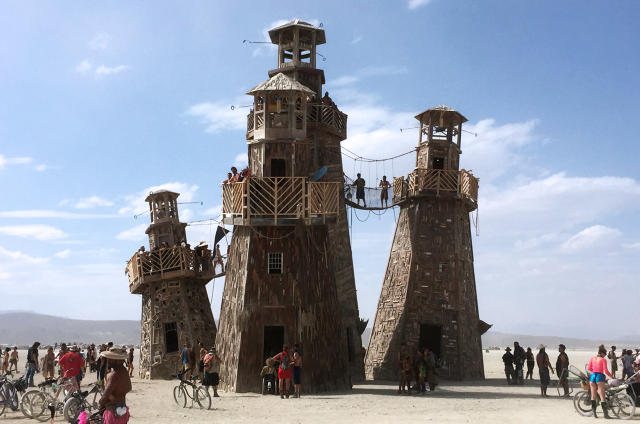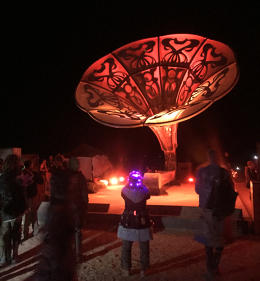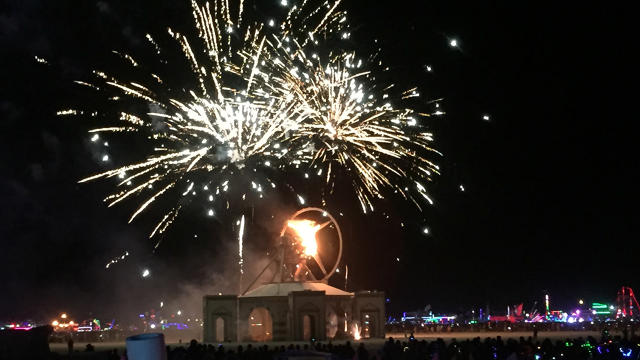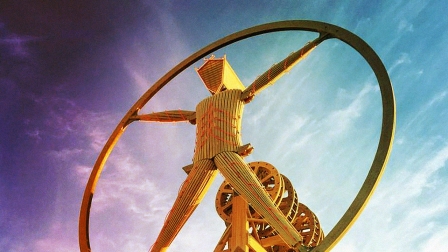Can You Still Unplug At Burning Man When The Cell Signal Is Strong?
Last Friday, as I finished gathering my things for a ride in my friends’ Burning Man art car, I realized they had left camp without me.
At an event in Nevada’s Black Rock Desert, one of the most remote areas in North America, this kind of situation usually entails figuring out a new plan, finding someone else to hang out with, or just going for a solo walk.
That’s because Burning Man has always been a place where—despite all the technology being used in the many art installations that delight tens of thousands of attendees who make the trek to the playa, as the Black Rock Desert is known—there has been almost no way to communicate with each other when not together, especially over the internet. And at an event where people go to “unplug,” that’s always been a good thing, even for the highly tech-savvy people who make up the bulk of the 70,000 attendees.

To be sure, people have used things like walkie-talkies to organize, and some volunteers and staff members rely on more powerful Motorola radios for essential communications. But beyond that, trying to rendezvous on the playa, especially at night, has been all but impossible.
Until this year.
Over the last couple of years, mobile connectivity has been creeping onto the playa from cell towers located somewhere near the desert’s edge. That has made it possible for people on-site early to send emails, browse Facebook, and check Twitter. But only before the event’s gate officially opened. Once the masses flooded in, the networks were overwhelmed and communication was basically impossible.
This year, Burning Man—which concluded Monday—was bathed in mobile internet, at least for those on AT&T’s network. Users of other carriers, such as Verizon, didn’t have quite the same experience, but AT&T customers like myself found that the signal was pretty much always there, making it possible to check the Web, catch up on Facebook, read some election news, or whatever. The one exception seemed to be during the burning of the Man, the event’s centerpiece, when most attendees were in the same place and, presumably, trying to upload pictures of the giant fire engulfing the effigy.

For me, being able to be online at all times was strange, but also useful. For example, I spent one day waiting for a message from a Burning Man spokesperson about the engineering problems that had led organizers to determine that the Man could not rotate as originally planned. For that, having connectivity was a necessity.
Yet I also found myself checking email or Twitter far more than I should have, given the plethora of things I could have been entertaining myself with.
I also often saw another friend, a hard-core Burning Man volunteer, frequently checking Facebook and a night or two before the event’s end, I frequently heard the tell-tale sound of a Facebook Messenger message arriving on his phone. It was very strange.

As noted above, though Burning Man is very much an event that celebrates technology—I’ve been calling it an engineering festival over the last few years, instead of an arts festival—being out of contact with the outside world has long been something people there have taken as an article of faith: The world will wait.
That has advantages and disadvantages, one being that you’re not always sure what people are telling you is true. For example, Princess Diana died during Burning Man 1997, and many attendees who heard the news assumed it was a hoax, given that it was the kind of thing that could easily have been a well-circulated rumor.
Another example was in 2005, when Hurricane Katrina battered New Orleans just as Burning Man was getting underway. Though many attendees had seen the news that the hurricane was bearing down on the Big Easy before arriving on the playa, no one really knew how serious it was, and real information was scarce.
Those two situations could never happen now. The connectivity is there, and people can find out real news about the rest of the world. Similarly, people will now be able to talk to friends or loved ones back in the real world if something serious happens, like a death in the family. Is that a good thing for Burning Man and one of the chief philosophies—immediacy—that people like to count on there? I have no idea. Only time will tell.
I did hear a story the other day about someone riding away on bike from the Temple burn—a somber event unlike the celebration that is the Man burn—reading their phone. That made a number of people I was with snort with derision. But who knows? In a year or two that could be any one of us.

I was cautioned against writing this article because it might alert too many people to the fact that connectivity is now something to count on at Burning Man. But I figure people already knew. I don’t think I talked to anyone on the playa this year who wasn’t aware of the situation. To be sure, I would hate to think that people will come next year and simply stay in camp reading the Web. My feeling, though, is that Burning Man will always provide too much for people to do—art, music, conversation, visual stimulus, etc.—for anyone to be attracted by their phone for more than a few minutes a day.
I will probably be proven wrong, and that will be a bad day for Burning Man.
But last Friday night, as I wandered out from camp feeling bad that my friends had abandoned me, I got a text message saying they had realized it, and that they wanted to figure out how to come and get me. A few messages later, their lovely art car, lit by bright LEDs, appeared out of the darkness, and I hopped on.
Ain’t progress grand?
Fast Company , Read Full Story
(43)


